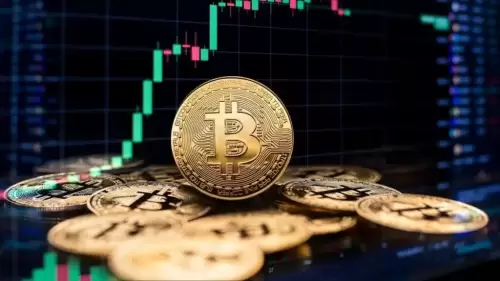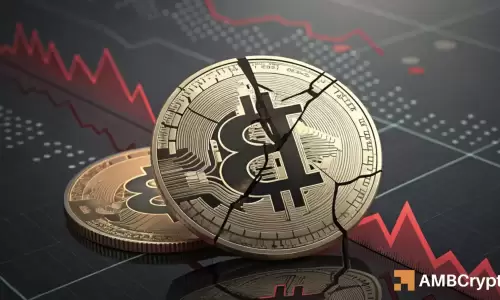 |
|
 |
|
 |
|
 |
|
 |
|
 |
|
 |
|
 |
|
 |
|
 |
|
 |
|
 |
|
 |
|
 |
|
 |
|
在加密貨幣和分散財務(DEFI)的世界中,您需要理解的許多最重要的概念似乎非常複雜。自動化交易所(AMM)的一種在分散交易所進行了顯著簡化交易的創新是。

In the rapidly evolving world of cryptocurrency and decentralized finance (DeFi), many of the most important concepts that you need to understand can seem overwhelmingly complex. However, some innovations in the industry have significantly simplified trading on decentralized exchanges.
在快速發展的加密貨幣和分散財務(DEFI)的世界中,您需要理解的許多最重要的概念似乎絕大部分複雜。但是,該行業的一些創新在分散交易所進行了大量簡化的交易。
One such innovation is the Automated Market Maker (AMM). An AMM doesn’t rely on traditional order books like centralized intermediaries do. Instead, it allows users to trade digital assets directly with each other using smart contracts. But how do AMMS work exactly, and why are they so important in the crypto ecosystem? Let’s break it down.
這樣的創新之一就是自動化做市商(AMM)。 AMM不依賴像中央媒介這樣的傳統訂單書。相反,它允許用戶使用智能合約直接互相交易數字資產。但是,AMM如何確切工作,為什麼它們在加密生態系統中如此重要?讓我們分解。
What Is an Automated Market Maker?
什麼是自動做市商?
An Automated Market Maker (AMM) is a protocol that facilitates the buying and selling of assets on a decentralized exchange (DEX) without the need for a centralized order book. Simply put, it’s a system that relies on algorithms to automatically set the asset prices based on supply and demand.
自動化做市商(AMM)是一項協議,可促進分散交易所(DEX)在不需要集中訂單的情況下購買和銷售資產。簡而言之,這是一個依賴算法來根據供求而自動設置資產價格的系統。
AMMs use liquidity pools, which are pools of tokens provided by users (or liquidity providers) to enable easier trading. When someone trades on an AMM, the transaction is executed directly with the liquidity pool rather than by matching buyers and sellers, as is common in traditional financial markets.
AMM使用流動性池,這些流動性池是用戶(或流動性提供商)提供的代幣池,以實現更容易的交易。當某人在AMM上進行交易時,交易是直接與流動性池執行的,而不是與買賣雙方匹配,就像傳統金融市場一樣。
Popular DEXs powered by AMMs, such as Uniswap, SushiSwap, and Curve Finance, have changed how we trade tokens and other digital assets. These tools give users more control and more transparency when making transactions.
由AMM提供動力的流行DEX,例如Uniswap,SushisWap和Curve Finance,已改變了我們交易代幣和其他數字資產的方式。這些工具在進行交易時為用戶提供了更多的控制和更透明度。
To help visualize how this works, here is a simple diagram from Uniswap’s docs, the most popular AMM-powered DEX, showing how tokens flow in and out of liquidity pools during a trade:
為了幫助您可視化它的工作原理,這是Unistwap文檔的簡單圖,這是最受歡迎的AMM驅動的DEX,顯示了代幣在交易過程中如何流入和流出流動性池:
How Automated Market Makers Work
自動化做市商的工作方式
Automated Market Makers (AMMs) alter the way people trade crypto by replacing order books with smart contracts and liquidity pools. Let’s take a closer look at how they actually function.
自動化的做市商(AMM)通過用智能合約和流動性池代替訂單書來改變人們交易加密貨幣的方式。讓我們仔細看看它們的實際運作方式。
No Buyers and Sellers – Only Liquidity Pools
沒有買家和賣家 - 只有流動性池
On traditional exchanges, you always need someone else on the other side of the trade. Automated Market Makers do away with this system. They don’t match buyers and sellers but instead use collections of tokens locked in smart contracts, famously known as liquidity pools.
在傳統交流上,您總是需要交易另一端的其他人。自動化的做市商取消了該系統。他們不匹配買賣雙方,而是使用鎖定智能合約的代幣集合,被稱為流動性池。
Let’s say that you want to trade ETH for USDC on Uniswap. You aren’t buying from a trader who has these coins and wishes to sell them. Instead, you are trading with a smart contract that holds a pool of both assets. The smart contract uses a formula to determine how much you will get in return for your trade on the platform.
假設您想在uniswap上以usdc交易ETH。您不是從擁有這些硬幣的交易者那裡購買的,並希望出售它們。取而代之的是,您正在使用擁有兩個資產庫的智能合約進行交易。智能合約使用公式來確定您將在平台上的交易中獲得多少回報。
The Constant Product Market Makers
恆定的產品做市商
At the heart of most AMMs is a simple yet powerful model known as a constant product market maker. The model uses this formula:
大多數AMM的核心是一種簡單而強大的模型,被稱為恆定的產品推銷商。該模型使用此公式:
X × Y = K
x×y = k
Here is an example of how the AMM adjusts prices automatically depending on how much is in the liquidity pool:
這是AMM如何根據流動性庫中自動調整價格的一個示例:
Imagine a liquidity pool with 10 ETH and 20,000 USDC. The AMM would plug these figures into the equation like so:
想像一個流動性池,有10個ETH和20,000 USDC。 AMM會這樣將這些數字插入方程式:
10 x 20,000 = 200,000
The result would be K = 200,000. If you decide to add 1 ETH to the pool and take out USDC instead, the new ETH balance would become 11. To keep K constant at 200,000, the pool must reduce the USDC by a specific amount. So now you have:
結果是k = 200,000。如果您決定在池中添加1個ETH並取出USDC,那麼新的ETH餘額將變為11。要使K恆定為200,000,池必須將USDC降低到特定的金額。所以現在您有:
11 x Y = 200,000
11 x y = 200,000
Y = 18,181.81 USDC (approximately)
y = 18,181.81 USDC(大約)
In the end, assuming the AMM calculates everything correctly, you would receive 20,000 – 18,181.81 = 1,818.19 USDC for your 1 ETH.
最後,假設AMM正確計算所有內容,則您將獲得20,000 - 18,181.81 = 1,818.19 USDC的1 ETH。
Constant Product Market Maker vs. Constant Sum Market Maker
恆定的產品做市商與恆定總和做市商
Some protocols, especially early or experimental ones, have used what we call a constant sum market maker model. These use a simpler formula:
某些協議,尤其是早期或實驗性的協議,已經使用了我們所謂的恆定總和做市商模型。這些使用更簡單的公式:
X + Y = K
x + y = k
This model keeps the total value of tokens constant, not the product. However, the model is avoided by major exchanges. It can be useful in certain low-volatility scenarios like stablecoin swaps, but constant sum market makers can actually run into major problems if one of the tokens in the liquidity pool runs out. Arbitrageurs could drain the pool completely at no cost.
該模型保持令牌恆定的總價值,而不是產品。但是,通過主要交流避免了模型。它在某些低揮發性方案(例如Stablecoin互換)中可能很有用,但是如果流動性池中的一個令牌耗盡,則恆定的總和做市商實際上可能會遇到主要問題。套利者可以免費耗盡游泳池。
That’s why the constant product model, used by Uniswap, PancakeSwap, and other DEXs, is considered much more robust. It guarantees liquidity at any price, even if the prices become extreme.
這就是為什麼uniswap,pancakeswap和其他DEX使用的恆定產品模型被認為更強大的原因。即使價格變得極端,它也可以以任何價格保證流動性。
Bigger Liquidity Pools = Better Prices
更大的流動性池=更高的價格
Generally, the more tokens in a liquidity pool, the smaller the price impact when you make your trade. This price impact is called slippage. In a smaller liquidity pool, a big trade can make a major shift in the price.
通常,流動性池中的令牌越多,進行交易時的價格影響越小。這種價格影響稱為滑移。在較小的流動性池中,大型交易可以使價格發生重大變化。
You can see why that happens if you plug a large transaction into a small pool’s constant product
您會看到為什麼將大型交易插入小型池的恆定產品時會發生這種情況
免責聲明:info@kdj.com
所提供的資訊並非交易建議。 kDJ.com對任何基於本文提供的資訊進行的投資不承擔任何責任。加密貨幣波動性較大,建議您充分研究後謹慎投資!
如果您認為本網站使用的內容侵犯了您的版權,請立即聯絡我們(info@kdj.com),我們將及時刪除。
-

-

-

-

-

-

- UNISWAP價格預測:看漲逆轉在地平線上?
- 2025-08-05 07:10:59
- UNISWAP(UNI)是否準備好看好逆轉?最近的市場分析表明潛在的上升性,但是哪些因素驅動了這種樂觀的前景?
-

- 比特幣,以太坊,Altcoin Rally:這是最大的嗎?
- 2025-08-05 07:01:56
- 加密貨幣市場正在加熱,以太坊領導了這一指控。這是主要的Altcoin集會的開始嗎?讓我們研究最新的趨勢和見解。
-

-

- 比特幣持有人準備在看跌信號的市場出口
- 2025-08-05 07:00:39
- 長期比特幣持有者顯示出市場退出的跡象,作為關鍵指標閃光燈信號,表明儘管價格提高,但仍有可能進行更正。





























































